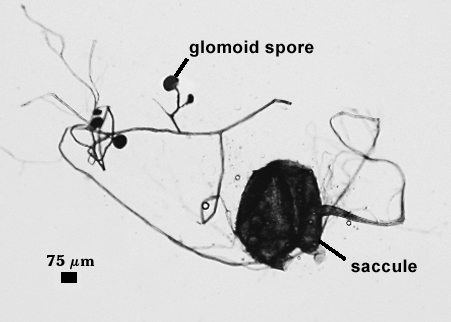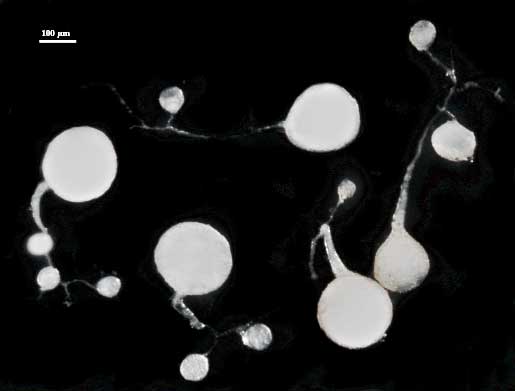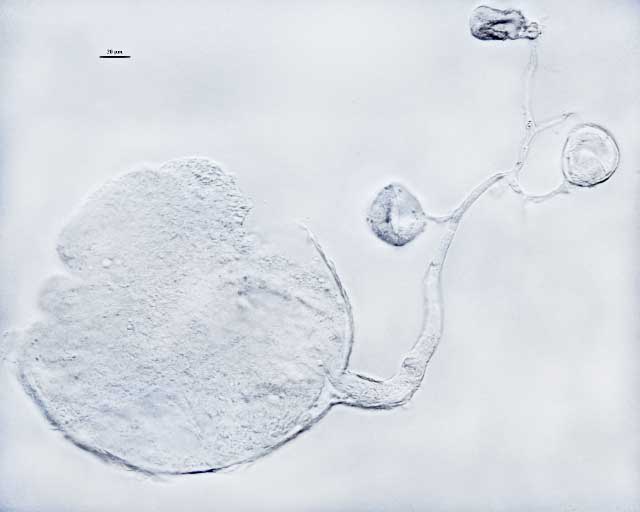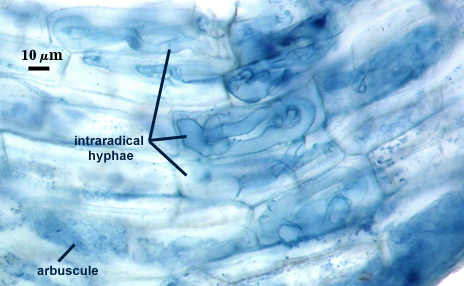Ambisporaceae Ambispora
C. Walker, Vestberg & Schüßler
If history illuminates the paths science has taken us, then this genus has been all over the map. It is far more complicated and confusing than it needs to be, and it all started with the publication by Spain et al. (2006), which split all the species Morton et al. (1997) had synonymized and returned them to Glomus or Acaulospora and transferred two dimorphic species to Appendicispora. Walker et al. (2007a) erected a new genus Ambispora and kept the original synonymizations, but then reclassified them as Appendicispora to adhere to the rule of nomenclatural priority (Walker et al. 2007b). Walker (2008) resurrected Ambispora because Appendicispora was a homonym (used elsewhere with another group of organisms). It only gets more complicated, which is reviewed a bit more on the Am. leptoticha page.
Acaulosporiod Morph
Spores originate from a short branch hypha (pedicel), which in turn branches from the hypha subtending a sporiferous saccule. Saccules expand blastically from the end of a fertile hypha. This expansion seems to cease at the onset of spore formation. Spores may retain the pedicel after detachment from a saccule or appear sessile if the pedicel breaks off at the spore base. Spores have a three-layered spore wall. The outer layer can degrade to varying degrees or can slough completely. The middle layer is continous with inner wall of the pedicel branching from the neck of the “sporiferous saccule”, and the inner layer has unique properties which, in combination with the phenotype of the middle layer, are diagnostic for each species. Spores do not form thin flexible “germinal walls” common to all species of Acaulosporaceae.
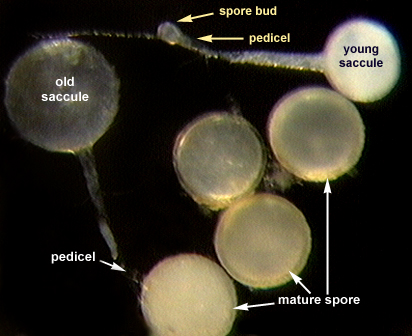
Glomoid Morph
Spores are typically glomoid; a broad range in size, even within individual populations; hyaline to pale cream in color; and with a two-layered spore wall continuous with a bilayered subtending hypha. Spore morphology is indistinguishable amongst species described to date in salient diagnostic characters.

| Arbuscules stain very faintly | ||
|---|---|---|
|
|
|
Mycorrhizae
Arbuscules generally stain very faintly (more so than in Acaulosporaceae) in conventional acidic stains. The photos at the bottom have been enhanced digitally to better visualize arbuscule structure. Patchily distributed within roots of corn, red clover and sudangrass (culture hosts used thus far). Narrow trunk hypha (< 4 µm), with fine branching near tips. Vesicles either have not been observed or occur only rarely in pot cultures. Intraradical hyphae tend to stain slightly less faintly than arbuscules and usually are the structures that identify foci of colonization. Spread both intra- and inter-cellularly, the former 3-10 µm wide and often coiled and the latter 2-8 µm wide, with some coiling and irregular branching. Extraradical hyphae generally are thin (2-3 µm wide), but profuse around roots. They often remain attached to roots in entry point regions.
| Mycorrhizal structures | ||
|---|---|---|
|
|
|
Reference
- Morton, J. B. and D. Redecker. 2001. Two new families of Glomales, Archaeosporaceae and Paraglomaceae, with two new genera Archaeospora and Paraglomus, based on concordant molecular and morphological characters. Mycologia 93:181-195.
- Morton, J. B., J. D. Bever and F. L. Pfleger. 1997. Taxonomy of Acaulospora gerdemannii and Glomus leptotichum, synamorphs of an arbuscular mycorrhizal fungus in Glomales. Mycological Research 101:625-631.
- Spain J. L., E. Sieverding and F. Oehl. 2006. Appendicispora: a new genus in the arbuscular mycorrhiza-forming Glomeromycetes, with a discussion of the genus Archaeospora. Mycotaxon 97:163-182.
- Walker, C., M. Vestberg, F. Demircik, H. Stockinger, M. Saito, H. Sawaki, I. Nishmura, and A. Schüßler A. 2007a. Molecular phylogeny and new taxa in the Archaeosporales (Glomeromycota): Ambispora fennica gen. sp. nov., Ambisporaceae fam. nov., and emendation of Archaeospora and Archaeosporaceae. Mycological Research 111:137-153.
- Walker, C., M. Vestberg, and A. Schüßler. 2007b. Nomenclatural clarification in Glomeromycota. Mycological Research 111:253-256.
- Walker, C. 2008. Ambispora and Ambisporaceae Resurrected. Mycological Research 112:297-298.
